The Grand Place (Grote Markt, Market Square)
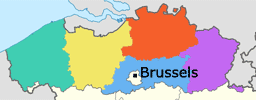 The Grand Place and also the Cathedral of Saint Gudula and Saint Michael can easily be reached from the Central Railway Station of Brussels. The Grand Place and also the Cathedral of Saint Gudula and Saint Michael can easily be reached from the Central Railway Station of Brussels.
The Grand Place started off as a market for trading goods. Initially wooden houses were scattered around the market, but from the 14th century stone mansions were erected.
From 1402 till 1455 the Town Hall was constructed.
Atop the spire on the square tower body, stands a 5-meter-high gilt metal statue of the Archangel Michael, the patron saint of Brussels, slaying a dragon or devil. The 96 meter high tower is in Brabantine Gothic style.
The facade of the town hall is decorated with numerous statues representing nobles, saints, and allegorical figures. The present figures are not the originals. The Grand Place was bombed in 1695 by the French. The damaged townhall had to be reconstructed. The interior was rebuilt, and the building expanded with rear wings.
 |
Town Hall of Brussels on Market Square.
Visit picture gallery of Grand Place of Brussels.
|
|
Most, but not all, of the houses around the square belonged to the guilds of Brussels, and as a group are referred to as the guild houses.
 |
Guild Houses on the Grand Square of Brussels. |
|
In 1695 almost all of the guild houses were destroyed, and needed rebuilding (between 1695 and 1700), but not in a willy nilly way. Restoration plans had to be followed, which makes for their uniform style up to this day. The more than twenty houses in between the Town Hall on one side of the square, and the King's House on the other side, have individual names, often related to the sculptures found on the houses or their roofs.
The houses on the Market Square have a similar style even now, after a few centuries, because the owners are bound to preserve as much as possible the original style of the buildings. The large building on the east side of the square is also known as the House of the Dukes of Brabant (while no dukes ever lived there, their statues adorn the building), and actually consists of 7 named guild houses.
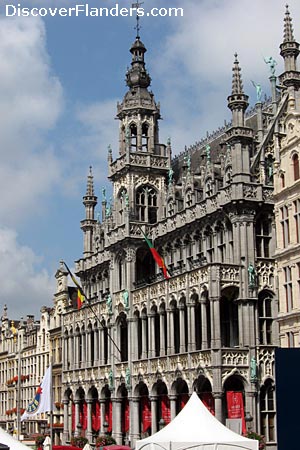 |
The King's House on Market Square of Brussels. |
|
The King's House on Market Square is located opposite the square of the Town Hall. In Dutch it is referred to as the 'broodhuis' (or bread house) which denotes is origin as a place were bread was sold. The stone building that replaced earlier wooden buildings, was later used as an administrative building by the Duke of Brabant.
The King's House was rebuilt in Gothic style from 1515 until 1536 during the reign of emperor Charles V. After 1695 the building needed restoring. Later on in the mid 19th century, when the building was in a very poor state, it was reconstructed in neo-gothic style. For a long time now, it functions as the City Museum of Brussels.
Cathedral of Saint Michael and Saint Gudula
As is often the case, the Cathedral of Saint Michael and Saint Gudula was built on top of older smaller churches. A larger church dates back to 1047, when construction was decided by Count Lambert II Balderic. It became the collegiate church of Saint Michael and later Saint Michael and Saint Gudula, after relics of the latter were transferred to the church. While this original church was in Romanesque style, a bigger one in Gothic style was started by Henry I, Duke of Brabant, in 1226. It took three centuries to complete.
The church suffered considerable damage in 1579 (religious conflicts in the Low Countries) and 1794 (during the French revolution).
In 1962 the collegiate church became the cathedral of the new Archdiocese of Mechelen-Brussels.
Contrary to some important churches of Flanders we visited lately, the Cathedral of Saint Michael and Saint Gudula is in good condition, both inside and outside.
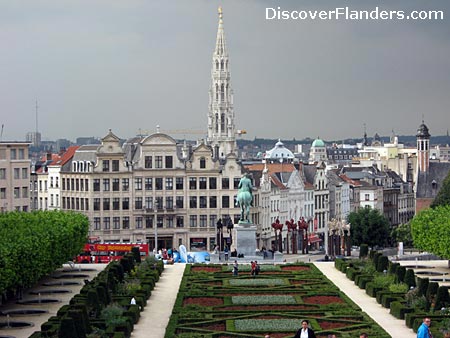 |
View over Brussels from the Coudenberg.
See picture gallery of a walk down the Koningsstraat (Rue Royale). |
|
Coudenberg or Koudenberg is a small hill where the Palace of Coudenberg used to be. The Palace of Coudenberg was the seat of government of the Duchy of Brabant from the 11th century until its destruction by fire in 1731. Later, the Royal Square ( Place Royale or Koningsplein ) was built on the ruins of the old palace.
In the middle of the square now stands the equestrian statue of Godfrey of Bouillon, the first ruler of the Kingdom of Jerusalem, at the times of the First Crusade.
The Royal Square on the Coudenberg is faced by the church of St. Jacob-on-the-Coudenberg from the late 18th century.
Our-Lady-of-the-Sablon church
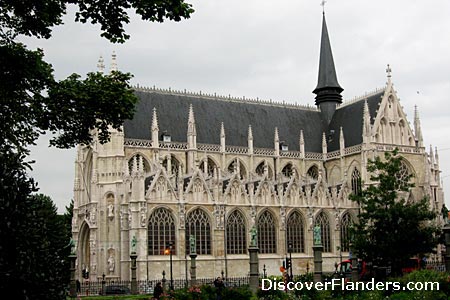 |
Our Lady-of-the-Sablon Church. |
|
An earlier chapel at the present location was transformed into the major gothic Sablon Church from 1436 until the beginning of the 16th century. A tower (as often in those days) was planned but never constructed. The church has been renovated and is in very good shape (also inside) with a number of splendid stained windows.
Opposite the church on the other side of the street is the pleasant small Zavel Park, with a statue of the historical figures Egmont and Hoorne, who were executed on orders of the infamous Duke of Alva under Spanish rule.
From the Coudenberg, there is a good view over the city of Brussels.
Royal Palace of Brussels
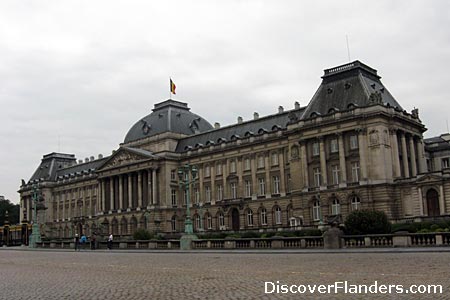 |
Royal Palace of Brussels. |
|
While it is not used as the royal residence (the Royal family lives in the Royal Castle of Laeken, on the outskirts of Brussels), the Royal Palace of Brussels is the official palace of the King of Belgium. With a long square in front, the Palace is located opposite the Brussels Park. On the other side of the park is the Palace of the Nation (the present Belgian Federal Parliament building). Both are relatively recent buildings from the beginning of the 19th century.
Brussels Palace of Justice (Justitiepaleis)
 |
The Dome of the Palace of Justice in Brussels. Under renovation. |
|
Situated on a hill, The Brussels Palace of Justice is a huge building, now being extensively renovated. It was built after the middle of the 19th century (1866-1883) but heavily damaged at the end of the Second World War. It was repaired after the war and is now a Unesco World Heritage site. The Palace is located on the Galgenberg hill, where in medieval times convicted criminals were hanged. There are some enormous statues inside the building. Altogether, the building is truly huge, measuring 160 by 150 meters. At present, while still good to visit and get an impression, most of the outer surface and the cupola is covered by scaffolding. |